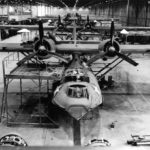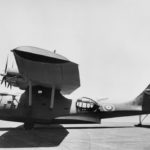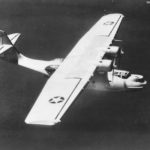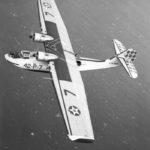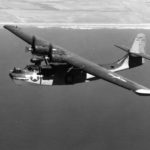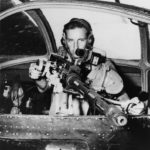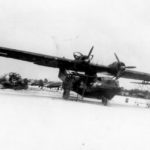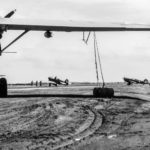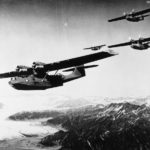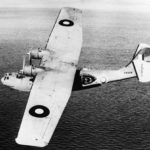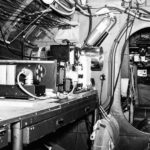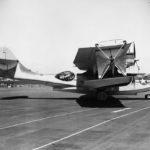RAF patrolling in PBY over Singapore 1941
Anchored Catalina Mk II AM269 BN-K of No. 240 Squadron RAF, Stranraer
PBY-5 production line 1942 2
Catalinas of VP-3 on nonstop flight from San Diego to Coco Solo 1937
Fleet Air Wing 4 Catalina in color Aleutians 1943
Coast Guard Consolidated PBY rescues downed F6F pilot
Catalina Mk I of No. 4 (Coastal) Operational Training Unit RAF, 1941
PBY-5A “P-5” of the VP-41 in Aleutian snow 1942
Seaplane tender hoists PBY-5 aboard for overhaul 1941
OA-10A 44-34056 of the 2nd Emergency Rescue Squadron named “I’ll be Seeing You” 1944
Wounded Marine put on PBY for transport from Bougainville
PBY-2 BuNo 0454 of the VP-54 – first U.S. Navy plane with radar NAS Norfolk
Catalina Mk IB (PBY-5B) FP111
Consolidated PBY-5 BuNo 08522 30 June 1943
PBN-1 Nomad in flight, March 1944
U.S. Catalina “White 13” at base in Western Australia 1943
PBY front view
Consolidated PBY-5A in Gale Adak Island 1943
Mechanics overhaul PBY at base in Western Australia 1943
PBY-5 Catalina in flight 1941
US submarine rescues crew members of PBY downed at sea 1945
Crew freeing PBY-5A from ice in Alaska 1943
Catalina flying out of Naval Air Station Argentia, Newfoundland 1944
PBY-5A in flight 8 March 1942 2
PBY-5A Catalina of the FAW-4 on Attu November 1943
Canadian Vickers OA-10A Catalina 44-34038 of the 1st Emergency Rescue Squadron, Foggia
PBY-5A code 4-J-9 of the VJ-4
OS2U Kingfisher and PBY-5 of the FAW-4 at Adak 1943
PBY-5 flying boat, San Francisco 1942 2
PBY-5 Catalina Mk IVA JX247 24 May 1943
Catalinas of the VP-12
PBY-5A Catalina with torpedo 1942
PB2B-2 Catalina Mk VI JX637 2
Crashed flying boat PBY-5A 1942
Catalina Mk IVB JX431 of No 205 Squadron RAF over Ceylon
XPBY-5A BuNo 1245 over San Diego 1939
PBY-3 BuNo 0842 October 1937
Flying boat PBY-2 BuNo 0474
PBY 1 takes off from San Francisco Bay 1939
PBY-2 42-P-7 of the VP-42 Alaska
PBY-5A Catalina of the VP-41 in Aleutian Snow 1942 2
PBY-6A BuNo 46642 February 1945
PBY-5A at NAS Daytona Beach, Florida on 20 December 1944
PBY-5A Black Cat of the VPB-54 being prepared for beaching at Kossol Roads November 1944
British Catalina P9630 over San Diego June 1939
PBY-5A amphibian side view
Catalina “Black Cat” Philipines
PBY-5A cockpit 1943
PBY-5 code 42-P-3 of the VP-42 over Alaska August 1942
RCAF Canso 9750, 3 January 1942
PBY-5 port waist gun blister open 2
PBY-5A of the VP-6 secured against high winds at Narsarsuaq Greenland in 1944
PBY-4 13-P-12 BuNo 1241 of the VP-13 in flight
Burning Catalina during Pearl Harbor Attack
PBN-1 Nomad “White 8” of the Russian Navy 1945
PBY-5 named “Able Mabel” bow twin gun position December 1942
PBY-2 “11-P-12” of the VP-11 1936 2
PBY-2 code 10-P-5″ of the VP-10
VP-44 PBY-5A crew that spotted Japanese approaching Midway
PBY-6A BuNo 46642 February 1945 2
British Catalina Mk I Z2136 26 May 1941
PBY-5 early 1942
PBY-5 V-189 of the USCG October 1940
PBY-5A Black Cat amphibian Peleliu
Crew with Catalina
PBY-2 “11-P-12” of the VP-11 1936
Catalina Mk IIIA FP529 amphibian in Prestwick
PBY-5A code 31P8 of the VP-31 at an East Coast 1942
PBY-5 1943 2
PBY-5A 8 March 1942
Catalina Mk I Z2147 AX-L of No 202 Squadron RAF
British PB2B-1 Catalina Mk IVB JX286 March 1944
RCAF Catalina W8434 QL-F
PBY-5 waist gun position
PBY-5 Black Cat waist gun position 28 September 1944
PBY-5A 118
Canso Catalina
Boeing PB2B-2 Catalina Mk VI JX637
PBY-5A cockpit 1943 2
PBN-1 Nomad of the Soviet Navy 1945 2
Refueling PBY in Aleutians 1943
PBN-1 Nomad 2
OA-10A 44-33915 “Sophisticat” of the 5th Emergency Rescue Squadron
USS Thetis Bay (CVE-90) transporting aircraft from Pearl Harbor to NAS Alameda 8 July 1944
PBY-5A of the FAW 4 over the Aleutians
PBY-5A
OA-10A from 5th of the 5th Emergency Rescue Squadron, Halesworth
PBY-5A “Black 18” of the VP-63 Gibraltar 1944
PBY-5A of the FAW-4 after skidding off the runway at Amchillea Island in January 1944
Late PBY-5A Aleutian Islands
PBY-5A of the VP-6 on Marston matting at Narsarsuaq, Greenland 1943
RCAF Canso 9706 Flying Boat
PBY-5 assembly line
PBN-1 Nomad “29” of the Russian Navy August 1945
Soviet GST Black Sea VVS
XPBY-5A BuNo 1245 over San Diego 1939 2
PBY-5 production line 1942
PBY-5A Peleliu
PBY-5A of the FAW-4 and 18th FS P-40 Cold Bay 11 May 1942
Catalina picks up sick sailor from U.S. submarine at sea 1943
PBY-5 of the VP-43 over Coast of Alaska August 1942
PBY-5A Catalina
OA-10A
Coast Guardsmen load water bombs on Catalina in Argentia 1944
PBY-5 flying boat during its take off run 1942
PBY-5 Aleutian 1943
PBY-6A Catalina 2
PBY-5 PTO 1942
PBY-5 bow twin gun position late
Catalina and B-17 of the 36th BS on Adak Island 1942
Catalinas of the FAW-4 Adak Island 1942, color photo
PBY-5A named “Double Trouble” New Guinea 1943
PBY-5A Catalina PTO
Catalina torpedo Loading
AR-8 rescue boat attached to wing of PBY-5A 1944
PBY-5 bow gun position
Bob Hope and his USO Tours
PBY-3 0842
Canadian Vickers OA-10A Catalina 44-33987
PBY-5 San Francisco 1942
USS Casco AVP-12 and PBY-5 of the FAW-4 Attu 1943
Consolidated OA-10 42-109024
British PBY-4 P9630 1939
PBY-5 1943
Catalina Mk I W8406 of No. 209 Squadron RAF January 1941
Wrecked Catalinas at Ford Island after Pearl Harbor Attack
Crew loads practice bombs on Catalina from VP-6 at NAS Argentia 1944
PBY-5 of the VP-41 in Blizzard Cold Bay Aleutians November 1942
Soviet PBN-1 KM-2 cargo conversion 1948
PBY-5A of the VP-6 in flight over Narsarsuaq Fjord Greenland in 1945
Catalinas of the VP-11
PBY-5A Catalina navigators compartment
Catalina Mk IVB JX286
PBY 205
Catalina Mk IVB JX286 March 1944 (Boeing PB2B-1)
PBY-5 late 1942
PBY-4 Catalinas
Consolidated PBY-5A
USAAF Catalina rescue B-17 Crew Sardinia 1943
PBY-5 Catalina 51P1 of the VP-51 Norfolk 1941
PBY-5A of the FAW-4 at flooded Adak Island fall 1942
Crew of VP-6 pictured in front of a PBY December 20, 1944
PBY-6A Catalina
PBY-1 Catalina 11-P-12 of the VP-11
Catalina 46572 late production December 1943
PBY-5A Pacific
PBY of U.S. Atlantic Air Patrol over convoy 1941
Catalina was an American flying boat and later an amphibious aircraft of the 1930s and 1940s produced by Consolidated Aircraft. It was one of the most widely used multi-role aircraft of World War II. PBYs served with every branch of the US military and in the air forces and navies of many other nations. In the United States Army Air Forces and later in the USAF their designation was the OA-10, while Canadian-built PBYs were known as the Canso.
Design and Structure
- Type: Twin-engined long-range patrol-bomber flying-boat.
- Wings:
- Configuration: Semi-cantilever high-wing monoplane.
- Design: The wing comprises three sections, with the center-section supported above the hull by a streamlined superstructure and braced by two pairs of parallel streamlined struts to the sides of the hull. The structure utilizes a beam bulkhead and stressed-skin design, reinforced with “Z” section extruded stiffeners. The trailing-edge section has aluminum alloy ribs cantilevered from the main beam, covered with fabric. The ailerons are balanced, aluminum-alloy framed, and fabric-covered.
- Hull:
- Design: Two-step, semi-circular topped hull of all-metal construction, using aluminum-alloy bulkheads, framing stringers, and skin.
- Floats: All-metal retractable wing-tip floats. When retracted, the floats form tips to the wings, with the float struts and bracing structure recessed flush with the lower surface of the wings. The mechanism for retraction is electrically and mechanically operated, with automatic locks and warning lights.
- Tail Unit:
- Type: Monoplane cantilever design.
- Structure: The lower fin is integrated with the hull, while the tail-plane and upper section of the fin are covered with smooth metal sheet, reinforced with extruded sections. The elevators and rudder are aluminum-alloy structures, covered with fabric and equipped with trimming-tabs.
Power Plant
- Engines: Two Pratt & Whitney Twin-Wasp R-1830-92 radial air-cooled engines, each producing 1,200 h.p.
- Mountings and Cowlings: Engines are mounted on welded steel-tube structures in the leading-edge of the center-section with NACA cowlings.
- Propellers: Hamilton-Standard Hydromatic constant-speed airscrews.
- Fuel Tanks: Protected fuel tanks with a capacity of 1,750 U.S. gallons are located in the center-section.
Accommodation
- Crew Areas:
- Bow Compartment: Contains mooring gear and other equipment.
- Pilot’s Compartment: Enclosed, seating two side-by-side with dual controls.
- Engineer’s Station: Located in the hull below the center-section.
- Gunner Positions: Two large transparent gun-blisters on the sides of the hull aft of the wings, each equipped with a Browning gun.
Dimensions and Loadings
- Dimensions:
- Span: 104 ft. (31.72 m)
- Length: 63 ft. 10 in. (19.52 m)
- Height: 18 ft. 10 in. (5.65 m)
- Wing Area: 1,400 sq. ft. (130 sq. m)
- Weights:
- Empty: 17,564 lbs. (7,974 kg)
- Loaded: 34,000 lbs. (15,436 kg)
- Wing Loading: 24.3 lbs./sq. ft. (118.5 kg./sq. m)
- Power Loading: 14.1 lbs./h.p. (6.4 kg./h.p.)
Performance
- Maximum Speed: 196 mph (314 km/h) at 7,500 ft. (2,290 m)
- Cruising Speed: 130 mph (208 km/h) at 10,000 ft. (3,050 m)
- Stalling Speed: 76 mph (122 km/h) at sea level
- Climb Rate:
- To 5,000 ft. (1,525 m): 4.5 minutes
- To 15,000 ft. (4,755 m): 16 minutes
- Service Ceiling: 18,200 ft. (5,550 m)
- Maximum Range: 3,100 miles (4,960 km) with 1,570 U.S. gallons of fuel at critical altitude


